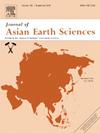Formation mechanism and geological significance of shale reservoirs in Cretaceous continental faulted basins of the Yanshan Tectonic belt, Northeastern China: A case study of the Luanping Basin
IF 2.7
3区 地球科学
Q2 GEOSCIENCES, MULTIDISCIPLINARY
引用次数: 0
Abstract
Shale oil and gas exploration in China has primarily focused on medium- to large-sized basins, with relatively few breakthroughs in small basins, particularly those within tectonic belts. The complexity of sedimentary environments in continental faulted basins often results in significant variations in shale oil and gas properties; thus, evaluating the potential in such basins is challenging. Luanping Basin is a typical faulted basin within the Yanshan Tectonic Belt. The successful drilling of Well LT1 marks the first exploration breakthrough for shale oil and gas in this region. This study analysed and evaluated the shale oil and gas characteristics in the Luanping Basin through lithofacies identification, sedimentary stage division, reservoir porosity and permeability features, sedimentary environmental analysis, and shale oil and gas properties. These results indicate that the Xiguayuan Formation in the Luanping Basin can be divided into five sedimentary stages based on volcanic activity characteristics. Stages 1–3, influenced by volcanic and hydrothermal activity, are the primary oil- and gas-producing layers. The reservoir space types include pores within the clay, dissolution, OM-hosted, intercrystalline, and intercrystal pyrite pores, grain-edge structural, and hydrocarbon generation fractures. Based on the total organic carbon (TOC) content, mineral composition, and sedimentary structure, nine lithofacies types were identified, with middle organic matter–laminated siliceous shale being the most favourable lithofacies type for shale oil and gas. The shale oil density was 0.75 g/cm3, viscosity was approximately 10 mPa·s, and the GOR ratio was as high as 980, which is superior to some developed continental basins in China. Sedimentary environmental analysis suggests that shale oil and gas developed in a semi-arid, semi-saline water sedimentary environment influenced by multiple sources, such as terrestrial, volcanic, and hydrothermal materials. This environment resulted in a higher reservoir brittleness index and significantly affected the hydrocarbon generation potential of the source rocks. Successful exploration in the Luanping Basin demonstrates that high-quality source rocks and reservoirs can form in complex tectonic belts with semi-arid lake environments, producing high-quality shale oil and gas resources, highlighting their unique characteristics.
求助全文
约1分钟内获得全文
求助全文
来源期刊

Journal of Asian Earth Sciences
地学-地球科学综合
CiteScore
5.90
自引率
10.00%
发文量
324
审稿时长
71 days
期刊介绍:
Journal of Asian Earth Sciences has an open access mirror journal Journal of Asian Earth Sciences: X, sharing the same aims and scope, editorial team, submission system and rigorous peer review.
The Journal of Asian Earth Sciences is an international interdisciplinary journal devoted to all aspects of research related to the solid Earth Sciences of Asia. The Journal publishes high quality, peer-reviewed scientific papers on the regional geology, tectonics, geochemistry and geophysics of Asia. It will be devoted primarily to research papers but short communications relating to new developments of broad interest, reviews and book reviews will also be included. Papers must have international appeal and should present work of more than local significance.
The scope includes deep processes of the Asian continent and its adjacent oceans; seismology and earthquakes; orogeny, magmatism, metamorphism and volcanism; growth, deformation and destruction of the Asian crust; crust-mantle interaction; evolution of life (early life, biostratigraphy, biogeography and mass-extinction); fluids, fluxes and reservoirs of mineral and energy resources; surface processes (weathering, erosion, transport and deposition of sediments) and resulting geomorphology; and the response of the Earth to global climate change as viewed within the Asian continent and surrounding oceans.
 求助内容:
求助内容: 应助结果提醒方式:
应助结果提醒方式:


